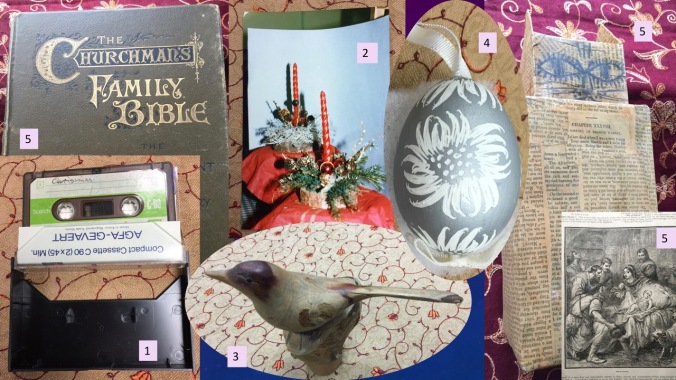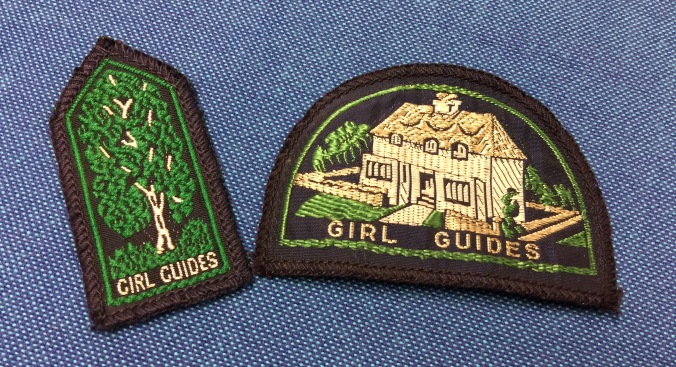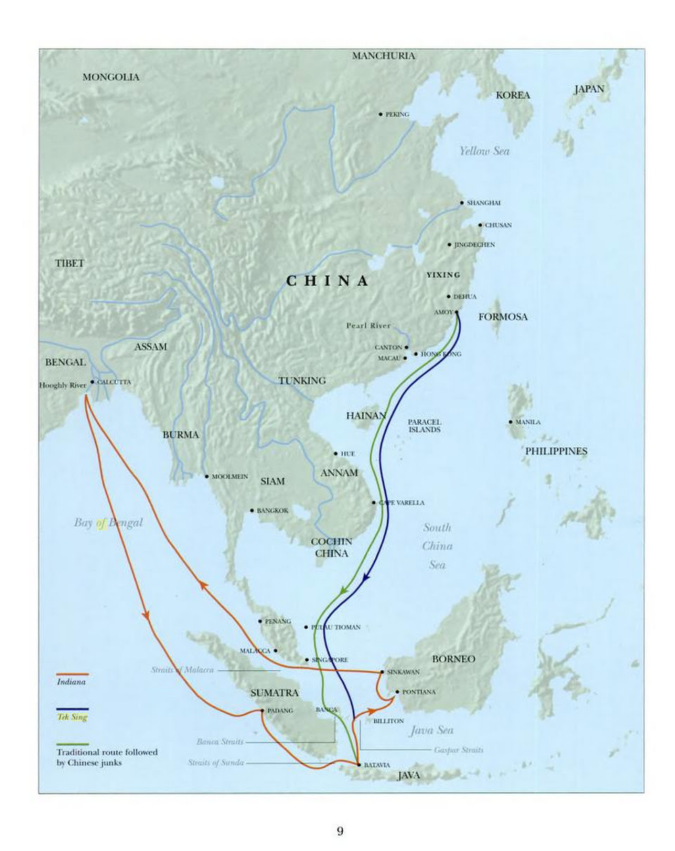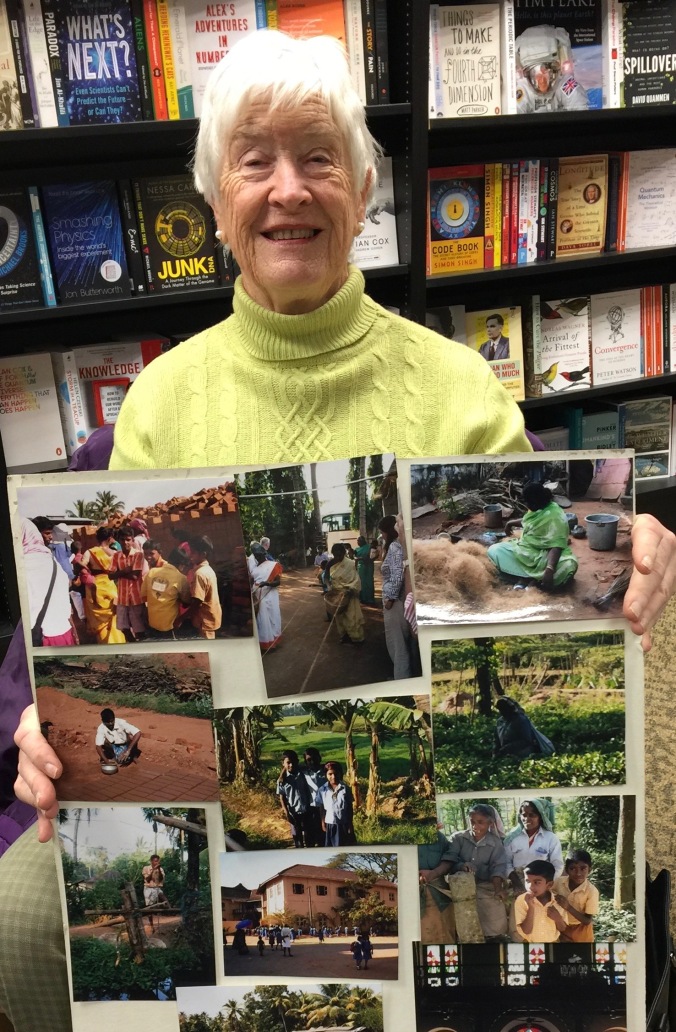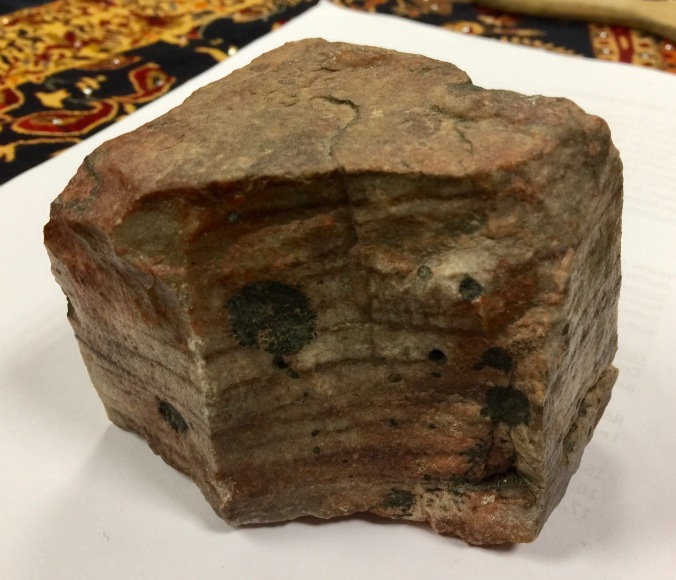Objects and Stories – 13th February 2018 – Ann Young
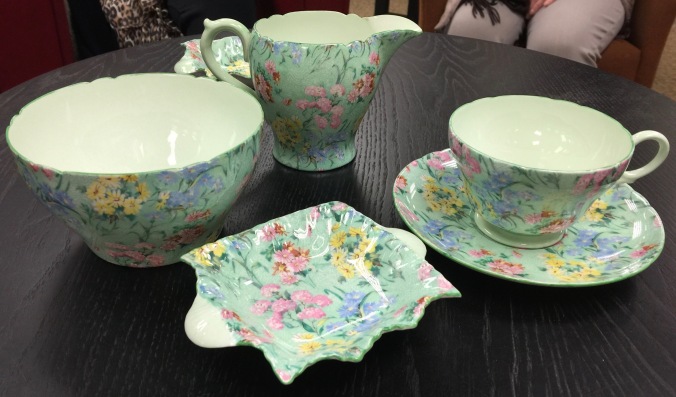
My father’s only sister was called Constance. However, their younger brother could not manage to say Constance or even Connie. He called her Toto and the name stuck with her for the rest of her life. She did not marry and so she took a very keen interest in the lives of her two nephews and two nieces ( my sister and myself). She had very dark hair in her youth and even when her hair turned snow white, she still had very dark eyebrows which complemented her lovely dark brown eyes. I particularly remember her sense of humour and her little Pekinese dog. Toto passed on a bone china tea set to me when I was married over forty years ago. As you can see, it is an all over floral pattern with a pale green background. My grandmother had had a similar tea set but the background was pale blue. It was passed on to my cousin. When I was growing up, my favourite colour was NOT pink, but green, especially pale green, so I was delighted to be given the green set rather than the blue one.
Looking at the tea cup reminds of some of my relatives, not just Toto who would have been 100 years old on New Year’s Day, this year.
My father was a physicist and if there was a debate about whether milk should be added before or after the tea is poured, he would insist that adding the milk after the tea made the resulting liquid the correct pH or level of acidity which suited his weak stomach. I believe the real reason for adding the cold milk first was to protect delicate china cups from the hot tea.
My mother and I enjoyed taking my daughter in her buggy shopping in Belfast. I would always say “Let’s have a cup of tea” and we would head for the nearest café. One day, Jennifer, aged about 2½, suddenly piped up from her buggy “Are we going to the cup of tea shop?” Ever since then cafés have been called cup of tea shops in our family.
My English grandmother was like myself, a bit of a butter fingered person. She once asked if we could take her to buy a tea set “just for breaking” in other words an everyday tea set.
I used the other china tea sets we were given as wedding presents but a lot of pieces got broken and eventually I was using mugs to dunk tea bags in. Nowadays afternoon tea is fashionable and vintage china is often used to serve it. I had my first formal afternoon tea in the foyer of a Dublin Hotel before they became so popular. I had noticed the menu in the lobby and was keen to try it. As this was before it became so fashionable, the rest of the family scoffed at me and won’t come with me. I was determined to have an afternoon tea and so sat by myself in splendid isolation. I felt like a grand lady with my silver tea pot, hot water pot and cake stand. I thoroughly enjoyed my dainty sandwiches, scones, cakes and pastries. These days afternoon teas are very popular and many hotels and cafes serve afternoon teas; often at eyewatering prices. I feel very smug that I was one of the first to sample one. My daughter and I enjoyed a lovely afternoon tea complete with a glass of Champagne at the Merchant Hotel in Belfast as part of my 60th birthday celebrations.
Anyway, back to Toto’s tea set. I had always just thought of it as a very sweet old-fashioned tea set – too delicate for everyday use and only to be used on very, very special occasions. Nothing particularly special about it. Then one day, while looking at the magazines in Eason’s, the cover of the BBC Homes and Antiques magazine caught my eye. It showed some flowery china including a jug which looked just like the pattern in Toto’s tea set. Intrigued, I looked at the article inside and decided that I would have to buy a copy. I kept the relevant pages from the magazine and hunted them out to prepare for this talk. I had thought that it must be about five years but certainly no more than ten years since I had bought the magazine. I was astounded to see the date on the magazine – September 2017 – over twenty years ago!

The article was written by Paul Atterbury of Antiques Roadshow fame. He states that “This type of flowery patterned china is called Chintzware”. I had only heard the word chintz being used to describe flowery patterned fabrics for curtains and sofa coverings. I happen to like chintz in moderation but some people would be a bit sniffy about it.
Mr Atterbury continues; “The sudden flourishing of collectible chintzware is largely thanks to our American cousins. The good news is that we may have valuable pieces blossoming at home.” Apparently, the craze for collecting this type of china started in 1996 and this is when it became known as Chintzware. Previously it would have listed in catalogues by the initials A.O.F, i.e. All Over Floral.
In the article Mr Atterbury says Chintz ware was made cheaply and cheerfully in good quantities between the two world wars. It is a group of china patterns featuring an overall design of flowers and leaves. The design became popular with English makers about 1928. Chintz ceramics went out of fashion in the 1960s when newly weds wanted simpler dinner sets.
Among the best known makes are Royal Doulton, Shelley, and Grimwades. There is a story that Lenard Grimwade of Royal Winton was inspired by the patterns of the aprons worn by the girls working in his Staffordshire factory. The patterns are certainly more like dress fabrics that curtain fabric patterns. Toto’s tea set was made by Shelley and the pattern is “Melody”. I love the names of the patterns which were often as pretty as the pattern for example Primrose, Sweet Pea, Marguerite, Sweet Nancy, although I think that some of the actual patterns are a bit sickly.
The patterns were applied as a transfer as opposed to being painted by hand. In the article, there is a photo of a Sweet Pea teapot lid from a Christie’s auction catalogue. It shows the join where the two edges of the transfer are not perfectly joined. Reading this made me examine Toto’s tea set more closely. Sure enough, it is possible to “see the join” on the sugar bowl.
I am not sure if the Chintzware fans are still as enthusiastic about this pretty type of china but I still like it. I have resolved to not to leave it gathering dust in the top cupboard in the hall. I plan to display some of it and use it more often. Why not enjoy it, even if some pieces gets broken along the way. After all, what could be better than a nice cup of tea, served in a pretty bone china cup.
Ann Young
